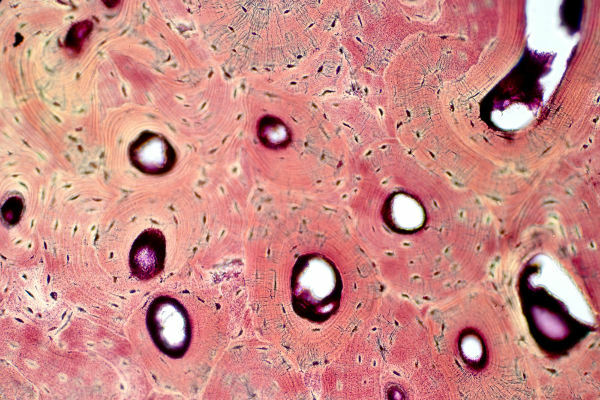Echinoderms (phylum Echinodermata) are invertebrate and exclusively marine animals.
Your body is generally organized into five symmetrical parts that are distributed in the shape of the rays of a circle.
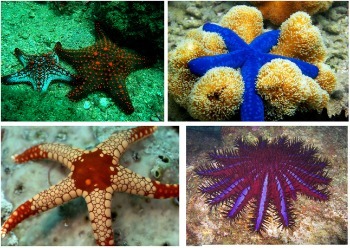 echinoderms
echinoderms
General features
The echinoderms are triblastic, coelom and deuterostomy. During the larval stage they present bilateral symmetry and in the adult stage, symmetry is radial.
Echinoderm animals have a great diversity of shapes, sizes and ways of life.
They are free-living and isolated animals, few species live fixed to a substrate. An example of a sessile echinoderm is the sea lily.
 Sea lily, a sessile echinoderm
Sea lily, a sessile echinoderm
Almost all of an echinoderm's systems, such as the digestive, nervous, and reproductive systems, lie within the limestone skeleton. This is covered by a thin layer of epidermis.
Some species may have thorns on the surface of the body.
know more about Celoma.
Circulatory and Excretory System
The circulatory system occurs through the aquifer or ambulatory system.It circulates water inside the body, allowing the transport of substances and locomotion.
At the same time, it also allows for excretion as it carries substances that need to be eliminated from the body.
How do echinoderms move?
The echinoderms move through the ambulacra feet, which are projections of the ambulacra system, sometimes with suction cups on the extremities.
The system has a mother-of-pearl plate, through which sea water enters the animal's body.
With the entry of water, the channels of the ampoules of the ambulatory system contract and carry the water to the foot, which elongates and fixes itself to the substrate. At this point, the suction cups help with fixation.
To leave the substrate, the water returns to the ampoules and relaxes the foot musculature, allowing it to release.
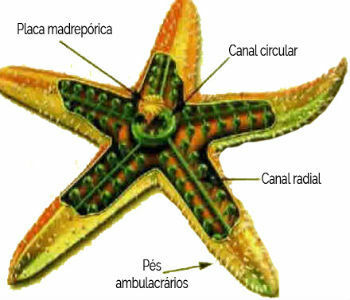
Starfish anatomy and ambulatory feet
Respiratory system
Echinoderms breathe through the gills that are close to the mouth. The ambulatory system also contributes to breathing through diffusion.
Digestive system
Echinoderms have a complete digestive system with mouth, esophagus, intestine and anus. The stomach is found only in carnivorous echinoderms.
Most species feed on marine algae. For this, they rely on Aristotle's lantern, which consists of a mouthpiece that scrapes food.
Carnivorous species, such as the starfish, feed on small animals. In this case, digestion takes place outside the body.
Starfish projects their stomach and digestive enzymes onto the food, which begins to be digested. Only then is it taken to the interior of your body, in order to complete the digestion.
reproduction
The reproduction is sexual. Echinoderms are mostly dioecious animals.
External fertilization takes place through the orifices of the genital plates, where the gametes come out into the water.
The formed zygotes generate larvae, which swim for some time, attaching themselves to a substrate and, through metamorphosis, give rise to adults. Therefore, development is indirect.
Classification of Echinoderms
It is estimated that there are 7,000 species of echinoderms divided into five classes:
asteroids
 starfish
starfish
The typical representative of the group is the starfish it has five arms arranged like spokes. Some even have forty arms.
In the part in contact with the substrate, the arms are formed by two rows of ambulatory feet, which allow movement and fixation.
At the end of each arm are rudimentary eyes, which allow you to locate their prey, such as annelids, crustaceans and oysters.
Starfish can perform autotomy, meaning the recovery of a lost arm. Also, the regeneration of a severed arm can form a new starfish.
Ophiuroids
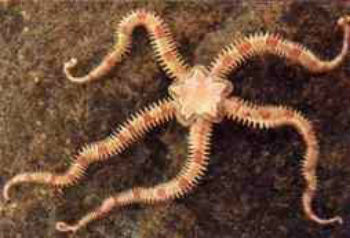 serpent of the sea
serpent of the sea
An example is the sea serpent which has a central disc from which five arms depart, endowed with undulating movements, which facilitate displacement.
The sea serpent has its mouth at the bottom, which is in contact with the substrate, while the anus is located on the opposite side.
Its food consists of molluscs, small crustaceans and sedimentary debris from the bottom of the sea.
Crinoids
 lily of the sea
lily of the sea
A representative of the crinoid group is the sea lily. It has a base attached to a substrate, from which five branched arms emerge that give the animal the appearance of a plant.
It uses as food the debris that permanently fall into its arms, which are covered by extensions capable of carrying the particles to its mouth.
Holotoroids
 Sea cucumber
Sea cucumber
O sea cucumber or sea cucumber has a cylindrical body, endowed with tiny unbonded plates, which give it a less rigid consistency.
Most are between 5 and 30 cm, with some specimens reaching up to two meters in length.
When attacked, it can eliminate part of your viscera, such as your intestines and gonads. The distracted predator allows the escape of the sea cucumber, which after a while has its parts regenerated.
Equinoids
 Sea urchin
Sea urchin
A representative of this group is the sea urchin or pinda. It has a body covered with mobile, poisonous thorns that are used for its movement.
Next to its mouth it has a five-pronged frame called an Aristotle's lantern. With this, it scrapes the rocks in search of algae, forming holes where these animals lodge.
Despite the thorns it can be attacked by various predators such as fish, starfish and crabs.
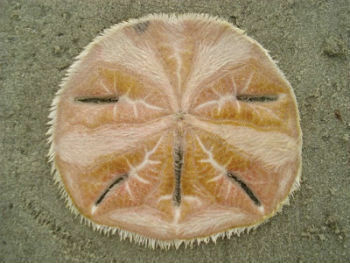 beach cookie
beach cookie
Another representative of the echinoid group is the beach cookie or corruption. The animal has a flattened body, like a disk, with the design of a star in the dorsal region.
This animal burrows superficially into the sand, where it obtains food made up of organic particles.
Curiosities
- Starfish have an excellent ability to regenerate. If you lose one of your arms, within a few months the limb is regenerated.
- There are no freshwater echinoderms.
Also read about:
- invertebrate animals
- Animal Kingdom

